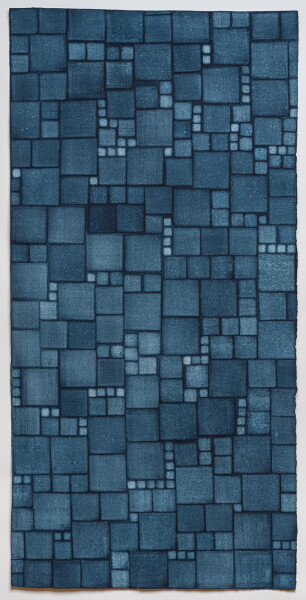 Whoever you are: in the evening step out
Whoever you are: in the evening step out
Of your room, where you know everything …
Rainer Maria Rilke, “Entrance”
Eventide began when I accepted Rilke’s invitation to step out of the place of knowing. An additive process I thought I understood accidentally turned subtractive, creating mysterious, dimensional forms far more compelling than what I’d originally intended. The forms turned into stones, the stones into pathways. I followed.
For Rilke, to leave the familiar well-lit room and step out into the twilit world is to enter a profound mystery; many of his poems are set at that achingly beautiful moment when “Slowly the evening changes into the clothes/held for it by a row of ancient trees….” What then is the color of that moment – of eventide?
My answer is indigo. Indigo is itself deeply mysterious: the complex sequence of steps required to turn plant into pigment is one of those improbable human discoveries whose origins we will never know. As a pigment, indigo contains multitudes, encompassing (nearly) all sixteen blues Rilke famously enumerated: a barely blue, a waxy blue, a listening blue, a blue dove-gray, a wet dark blue, a juicy blue, a light cloudy blue, a thunderstorm blue, a bourgeois cotton blue, a densely quilted blue, an ancient Egyptian shadow-blue, a self-contained blue and a completely supportless blue.
To be clear: this series isn’t about Rilke. And yet. As a recent widow, plunged suddenly into a wholly unfamiliar life, I’ve been spending a lot of time with the poet of the “great grief cry,” the poet who implores us to embrace uncertainty, to be “patient toward all that is unsolved in your heart and to try to love the questions themselves like locked rooms and like books that are written in a very foreign tongue.”
I am trying to love the questions. To wonder whether, when we cross the threshold into the unknown, ‘an accident waiting to happen’ might be not a stern warning but an open-hearted promise.
